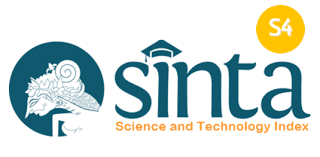GOES: GO EMERGENCY SERVICE, ANDROID-BASED SYSTEM AS A LABOR SAVING EFFORT IN REMOTE AREAS WITH NETWORK REACH
Abstract
Maternal mortality occurs because they do not have access to quality health services, especially emergency health services on time which are motivated by being late in recognizing danger signs, being late in making decisions, being late in reaching health facilities, and being late in getting services at health facilities and influenced by direct causes such as obstetric complications. 90%) is known as the classic triad (bleeding, infection and preeclampsia, or complications during pregnancy, birth, and postpartum that are not handled properly and on time). Many Indonesians live in remote areas, unlike people who live in urban areas, where access is easy to get medical assistance for delivery if they experience contractions and/or during labor, while people who live in remote areas must take a long time and long distances to get health services, so it is undeniable that many still use village shamans or village shamans as the closest alternative to getting assistance during childbirth. The purpose of this program is as an effort to save childbirth in remote areas that can make it easier for people who are far from the facility to get help more quickly during childbirth and are assisted by midwives who are experts in their fields. The method used in this activity is to create a framework where the framework will outline the sequence to be implemented. Based on the results of the activity, using the GOES application makes it very easy to access health services that are fast and appropriate for mothers and babies to more easily get help from medical personnel who are experts in their fields.
Keywords
Full Text:
PDFReferences
Ardhiyanti Y. SS. Factors of The Mother Related to Obstructed Labour Case at RSUD Arifin Achmad Pekanbaru. Jurnal Kesehatan Komunitas.Vol. 3(2). 2016;
Murdayah, Lilis DN, Lovita E. Faktor-faktor yang berhubungan dengan kecemasan pada ibu bersalin. Jambura J Heal Sci Res. 2021;3(1):115-25.
Shodiqoh E.R SF. Perbedaan Tingkat Kecemasan dalam Menghadapi persalinan Antara Primigravida dan Multigravida. J Berk Epidemiol. 2014;Vol. 2(1):141-50.
Fikri, I. dkk. Aplikasi Navigasi Berbasis Perangkat Bergerak Dengan Menggunakan Platform Wikitude Untuk Studi Kasus Lingkungan ITS. Jurnal Teknik ITS. Vol. 7(2). 2016;
Dewi, N. dkk. Rancang Bangun Aplikasi Mobile Siska Berbasis Android. Sci Inf Technol Journal. 2018;Vol. 1(2):100-7.
Utarini A. DH. Keselamatan Pasien dan Mutu Pelayanan Kesehatan:Menuju Kemana?. J Manaj Pelayanan Kesehatan. 2012;Vol. 15(4):159-60.
Nurrizka R. H. SW. Pengukuran Indeks Kepuasan Masyarakat Terhadap Pelayanan Kesehatan. Jurnal Manajemen Pelayanan Kesehatan.Vol. 14(1) : 11-19. 2011.
Wamiliana. dkk. Pembangunan sistem operasi berbasis linux menggunakan metode linux from scratch. Jurnal Komputasi. Vol. 1(2): 30-37. 2013;
Tumiwa R. dkk. Efektivitas Kualitas Pelayanan Kesehatan Masyarakat Pada Puskesmas Di Kecamatan Dumoga. J Eksekutif Vol 1(1). 2018;
DOI: https://doi.org/10.35971/jjhsr.v4i1.11909
Refbacks
- There are currently no refbacks.

This work is licensed under a Creative Commons Attribution-ShareAlike 4.0 International License.
Jambura Journal of Health Sciences and Research is licensed under a Creative Commons Attribution-ShareAlike 4.0 International License
</p



_.png)




_edit.png)




